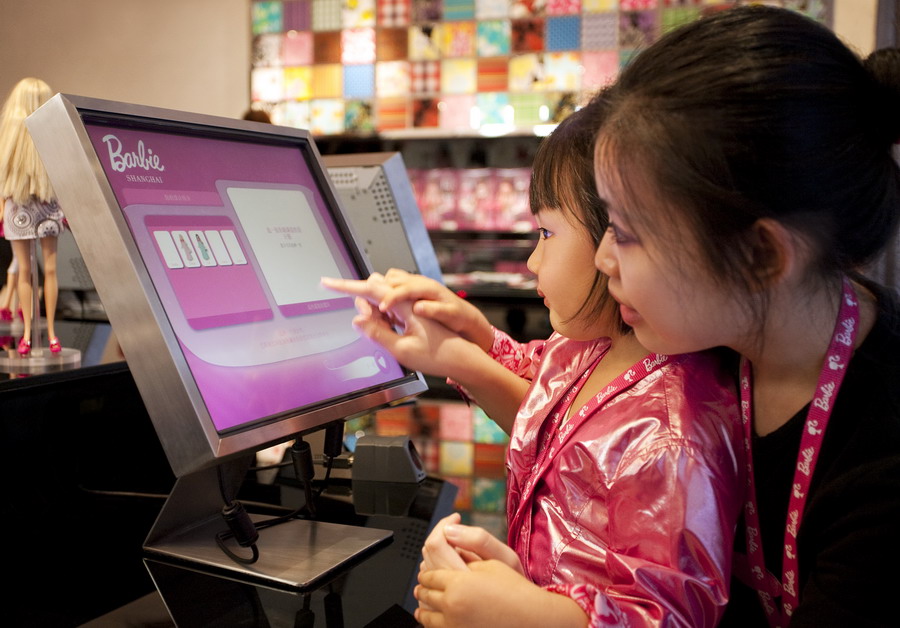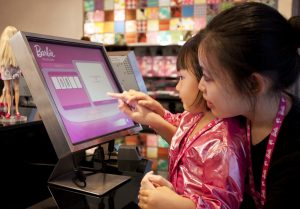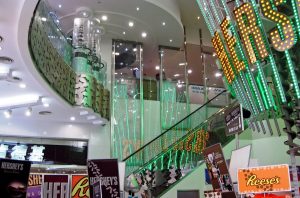When you start digging down into China’s robust retail sector, it becomes obvious fairly quickly that there’s a lot of misinformation and disinformation. Think of it as a centuries-long version of the old telephone game, with each person embellishing on and interpreting some nugget of truth, and you’ll get the idea. VMSD asked experts in design and retailing for help in separating fact from fiction.
Myth: Retail in China is synonymous with gateway cities.
Reality: “Only 9 percent of China’s retail market is located in tier 1 cities, yet this is where most brands concentrate their retail. So the biggest opportunities are in tier 2 and tier 3 cities”—Rick Keller, senior partner, Vertical Retail. The caveat: Most retailers will need to establish a core presence in Beijing, Shanghai and/or one of the major urban areas.
Alternate reality: “Some first-tier cities such as Chongqing, Xi’an and Nanjing haven’t reached their full buying power for foreign luxury brands. But they’ve been perfect incubators for Chinese domestic retailers in which to build business and establish their brands for future expansion. Suning Electronic, Golden Eagle and Tonlion are just some examples”—Cho Suzumura, designer, MulvannyG2 Architecture
Myth: China’s only about luxury.
Reality: Though China’s luxury market is robust and growing (estimates are that it will surpass Japan as the world’s largest luxury goods consumer by 2015), the growing middle class is the market to watch.
What they’re buying:
Advertisement
• “China’s a prime location for hypermarkets and megastores. International department stores are just starting to break into the market. Domestic retailers in the household appliance and consumer electronic sectors have been expanding in secondary cities. More than 20 percent of their sales come from their outlet stores”—Song Pak, chief creative officer, AMM Asset Development
• “We see lots of opportunities for kids’ retail. Most families have only one child (maybe, two) and, as a result, parents truly dote on their kids. Because there is so much emphasis on learning in China, kids are in school six days a week. And their day off is still packed—music lessons, art classes, things like that. There is some play for play’s sake, but there is a lot of interest in incorporating a learning component into play. That carries over into retail. It’s about shopping but it’s also about doing and learning”—Gretchen Ardizzone, strategic resource coordinator, Chute Gerdeman
Myth: China’s retail sector is driven by a jumble of independent shops.
Reality: “China has moved quickly from being a country where retail was primarily grass roots and complexly multi-leveled to one in which approximately 35 percent of current retail sales is done through what we could consider rationalized retail—chains, nationwide practices, flatted distribution systems, and so on—selling branded products. But Chinese retailers need to understand how design—beyond styling, image and impression—provides a strategic branding tool. U.S. design and branding firms’ skills in understanding brands, consumer behavior and the need for long-term planning present a great opportunity in China”—David Nelson, vp client strategy, JGA
Myth: China’s retail design is a step behind.
Reality: “In some ways, retail design is still in its formative stage in China. But in other ways, China’s stores are setting the trends. The markets in Beijing and Shanghai offers some of the best shopping—and coolest stores—in the world”—Paula Stafford, executive vice president, Callison,
Advertisement
Myth: For leases, just name your price.
Reality: “In major market such as Shanghai, retail rents declined by 3.8 percent since the peak in the last quarter of 2008. But, the dramatic rental drops witnessed in some of Shanghai’s other commercial real estate haven’t been seen in the prime retail sector. That’s largely because vacancy rates remain low. We expect retail rents to be stable in Shanghai until the 2010 due to the impact of the World Expo”—Eugene Tang, head of retail for central China, Jones Lang LaSalle.
SIDEBAR I: How China Shops
Retail therapy is pretty much the same in Beijing as in New York or London.
It’s hard to find the difference between today’s retail consumer in China and his or her counterpart in any of the world’s major markets. “Chinese shoppers in tier 1 and 2 cities are now as sophisticated as pretty much any other Asian consumer in Korea, Hong Kong, Singapore, etc. Talking about Chinese consumers as being radically different is for hack business writers looking to turn a dime from wide-eyed MBAs,” says Paul French, founder and publishing/marketing director for the market research firm Access Asia. “It’s economics, not culture. When money was tight, Chinese consumers fought for a bargain; now they’ don’t—it’s a factor wealth.”
It’s what they expect from store design and merchandising that is evolving, forcing a virtual visual revolution. “Historically, when shoppers were concerned primarily about price, they didn’t really care about how products were merchandised. Items were just piled on tables or in bins,” says Rick Keller, senior partner, Vertical Retail. Now Chinese consumers have higher expectations about the quality of products and the shopping experience.” Surveys bear that out, says Cho Suzumura, designer, Mulvanny2 Architecture. “The top factor Chinese shopper consider in deciding where to shop these days is convenience, followed by spaciousness and comfort of the stores and their selection.”
Advertisement
Keller sees retail designers addressing that by removing crowded window displays that block visibility and letting the store become the display. “Yes, there are still window displays, but they’re designed to let the consumer experience the store from the outside and then get drawn in to continue the experience,” he says.
Once inside, stores are doing more to establish individual identities. It helps that budgets allow for custom fixtures, furniture and even wall paper and tile patterns within the given budgets. “In the United States, labor is proportionately more expensive that materials. To stay on budget, we’re pushed to find off-the-shelf fixtures, furniture, furnishings and materials. In China, the cost difference between off-the-shelf and custom is not significant in many cases,” says James Slade, principal, Slade Architecture. “True, the ability to control quality in custom elements falls on the designer. But there’s also the opportunity to fashion a more distinctive environment.”
Brand consciousness is still a high priority among Chinese consumers. Keller recommends integrating brand names and logos into store design. “Colors are important and having brand/theming colors can be very effective in establishing an image,” he says.
With Chinese consumers becoming “image” shoppers, U.S. retail designers have an opportunity to apply their expertise to merchandising, way-finding systems and store layout. “That way, retailers can use cross-selling to sell more product,” says Suzumura.
Some brands he sees as trendsetters: Barnes & Noble; Starbucks; Apple; IKEA; Nokia and home furnishings retailer B&Q for their total retail experience; in the luxury category, Chanel, Trussardi, GUESS, Prada and Gucci. Among China’s home-grown, he cites apparel stores Shanghai Tan and Ni-Tiger.
Specialty markets, such as children’s retailing, have design rules of their. Spaces have to be interesting to both parents and kids, says Gretchen Ardizzone, strategic resource coordinator, Chute Gerdeman. Working within the framework of Slade Architecture’s design, Chute Gerdeman collaborated with Mattel to choreograph the customer experience at the Barbie Shanghai store’s fashion stage and design center.
“Parents and kids really have limited time to spend together, so an activity that they can share is important. Moms in China want to experience what their children experience because those sorts of things weren’t around when they were young,” says Ardizzone.
The trend now is for kids’ retailers in malls and stand-alone stores are making room for activity and experience zones. Design also tends to leave more space around these environments. “The customer journey is different in Shanghai that in the West in the sense that shoppers don’t wait in orderly queues. It’s more of a controlled chaos,” adds Ardizzone. “That’s not to say it’s better or worse—just that designers have to recognize it’s different.”
Adults want their retail with a dose of entertainment, too, says Paula Stafford, executive vp, Callison. Retail complexes are being integrated into mixed use communities, creating lifestyle destinations for office workers, residents and people who just want to dine out, have a drink or shop. “It’s not uncommon to see ice rinks and a lot of space devoted to food and beverage. We’re not just talking about the typical food court; there’s a range of offers including destination restaurants and bars. The foot traffic is double what you’d expect in a Western mall,” she says. Nor is there high mix of stores at varying price point—though that may change as upwardly mobile shoppers seek affordable versions of luxury fashions and home goods.
It all comes down to knowing the customer. As the experts interviewed for this report pointed out, China’s consumers, like consumers everywhere, have their preferences. Beijing shoppers tend to like elegance with an edge while in Shanghai the vibe is younger, hipper, more experimental. Tastes vary from north to south, and from city to city. “Getting immersed in another culture is one of the memorable and rewarding aspects of doing projects in other countries. Even though you make not speak the language, the expression on the customer’s face when he or she gets to experience what you created speaks a thousand words,” says Ardizzone.
SIDEBAR II: Work Smart in China
Long-haul design is a challenge, even with the best technology. To make the process smoother, follow these rules from designers who’ve been there, done that.
• Work with clients to set-up a face-to-face kick-off meeting. “Our client for Barbie Shanghai was insightful and skilled in creating a team dynamic. They launched the project with a 10-day trip for the entire team (including architects, activity designers, consultants, etc.) to Shanghai. It was a big investment, but the relationships and broad-stroke brainstorming that came out of that experience proved to be well worth it. As the project moved forward, the communication was often strictly conference calls. So the fact that everyone had this common introductory experience was invaluable in making the team connect”—Hayes Slade, principal, Slade Architecture
• Choose your partner carefully. “Many decisions seem to be at the discretion of individuals in different departments. At times, there doesn’t seem to be a prescribed process or even a set of code/reference standards. Review boards have a lot of discretion and, many times, politics are at play in their decisions. It is important to have a local partner with experience navigating the different agencies”—James Slade, principal, Slade Architecture
• Don’t take space in empty malls because it’s there. “Consolidate your store sales before launching a big expansion. Roll out in regions such as the Yangtze Delta or the Beijing-Tianjin corridor rather than jumping around the map to retain control of logistics”—Paul French, founder and publishing/marketing director, AccessAsia
• Know the local materials market. “Importing certain categories of items can be difficult and expensive. It’s important to build a library of materials sourced in China. The upside is that, in China, nothing is impossible. Whether it’s resources or labor, you can make tight deadlines work”—Paul Makowicki, principal, Callison
• Do your homework. “You need to have a strong relationship with your partner, but you also need to understand how business gets done. For example, it’s approximate three times more expensive to do projects in major cities within Mainland China than in Hong Kong. China restricts the number of work permits, so you’ll have to find good local workers. And finding skilled workers is a challenge. It’s tough to maintain standards unless you have a partner who will monitor quality control stringently. You have to know that contracts and construction drawings also needs to be written in both Mandarin and English, so you need a native speaker on staff if you’re really going to have a dialogue and ensure information is not ‘lost in translation.’ You also need to address in what currency your contract will be written and, if you want to establish a company, how much money can go into and be taken out of China and how long does it takes. It’s one reason a lot of companies have branch offices in Hong Kong or main cities in China”—Mary Mark, senior team leader, Yabu Pushelberg


 Photo Gallery1 week ago
Photo Gallery1 week ago
 Headlines7 days ago
Headlines7 days ago
 Headlines1 week ago
Headlines1 week ago
 Headlines2 weeks ago
Headlines2 weeks ago
 Headlines1 week ago
Headlines1 week ago
 Designer Dozen2 weeks ago
Designer Dozen2 weeks ago
 Designer Dozen5 days ago
Designer Dozen5 days ago
 Headlines7 days ago
Headlines7 days ago



















